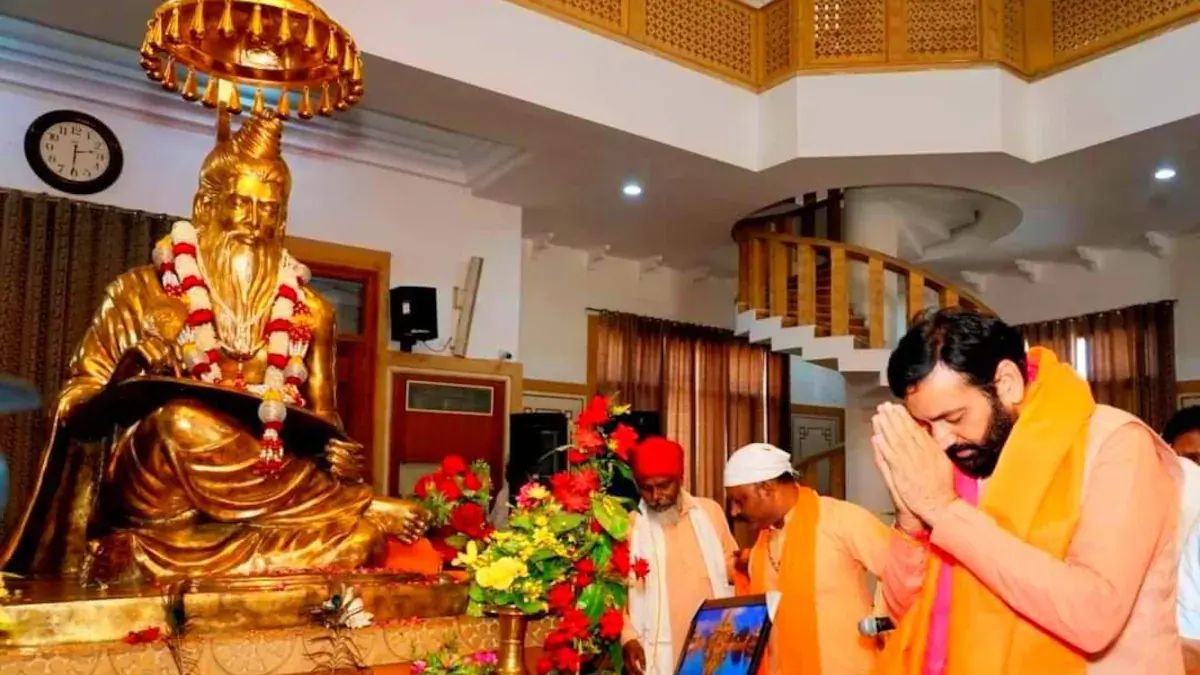Nayab Singh Saini’s swearing-in ceremony as Haryana’s Chief Minister coincided with Maharishi Valmiki Jayanti, marking a significant day in Haryana’s political landscape. The event, held in Panchkula, drew considerable attention due to the presence of prominent NDA leaders and the significance of the religious occasion. Saini’s visit to the Valmiki Temple before the ceremony underscored the blend of political and religious aspects of the day, highlighting his reverence for the deity and potentially seeking blessings for his new role. The event also represented the BJP’s third consecutive government formation in Haryana, a testament to their political dominance in the state. The newly elected Chief Minister’s emphasis on job creation and transparent governance showcased his vision for Haryana’s future, projecting an image of efficiency and promise to the state’s populace.
Saini’s Oath-Taking Ceremony: A Blend of Politics and Spirituality
A Visit to Valmiki Temple
Before assuming his role as the Chief Minister, Nayab Singh Saini paid his respects at the Valmiki Temple in Panchkula. This visit held symbolic importance, linking the political event with the religious celebration of Maharishi Valmiki Jayanti. Saini expressed his belief that Valmiki’s teachings promote societal good and emphasized his own commitment to fostering a just and ethical government. This action suggests an attempt to connect with the broader population and portray himself as a leader committed to upholding ethical principles, beyond mere political power. His comments on Valmiki’s contribution to societal good could also be seen as a deliberate political strategy – aiming to appeal to religious sentiments while highlighting a commitment to social justice and moral governance. The timing of the visit, just before the oath-taking ceremony, further magnified its significance, both politically and spiritually.
A Display of NDA Unity
The ceremony attracted many key figures from the NDA, including Prime Minister Narendra Modi. This significant turnout underscored the strength and unity of the NDA coalition, which appears poised for continued dominance in Haryana. The presence of several other chief ministers and union ministers showcased a demonstration of solidarity, lending further legitimacy and authority to Saini’s new position. Beyond simply celebrating the occasion, this event also served as a platform for strategic political alliances and networking opportunities for the various leaders present, further highlighting the significant political power represented within this ceremony. The strong turnout and the prominent leaders attending reinforced BJP’s continued dominance within Haryana and on the national stage.
The Haryana BJP’s Continued Dominance
Third Consecutive Government Formation
The BJP’s victory in the recent Haryana assembly elections, leading to their third consecutive government formation, reinforces the party’s firm hold on the state’s political landscape. This victory demonstrated considerable success in implementing policies deemed attractive to the electorate. This success underscores a certain stability and effectiveness in the BJP’s strategy that has resonated with the people of Haryana, paving the way for continued progress.
Promises of Transparency and Job Creation
Saini’s post-ceremony statements indicated a focused approach to governance, highlighting promises of job creation and transparent administration. This direct address to the concerns of the people speaks to a focused, goal-oriented approach from the newly elected CM, prioritizing improvements in the lives of Haryana’s citizens. This emphasis represents an effort to build trust with the people of Haryana and secure ongoing support, addressing directly the needs of the common people. By highlighting the creation of jobs without any need for corrupt practices (“Kharcha or Parcha”), Saini appealed directly to public desires for efficient, transparent administration, strengthening his position as the state’s new leader.
Looking Ahead: Challenges and Opportunities for the New Government
Post-Swearing-in NDA Meeting
Following the swearing-in ceremony, an NDA meeting was scheduled, emphasizing the ongoing alliance’s significance. This meeting provided an opportunity for strategic discussions, political planning, and an overall assessment of the current governmental climate. This post-ceremony gathering signifies the national party’s commitment and involvement in continuing cooperation with Haryana’s government. Such coordination creates the framework for national policy impacts and resource distribution, leading to better integration across national and state levels. This meeting served to highlight the party’s strength and capacity for national influence.
Economic and Social Development
The new government will face a considerable array of tasks that would test their commitment to delivering what was promised before and after election. The new government must now address various socio-economic issues concerning growth and stability. Implementing promised policy reforms and economic changes is critical. Ensuring the delivery of efficient public services will demand careful administration and commitment. Successfully balancing competing needs will be a significant factor in building on previous successes and strengthening the stability of the region under BJP. This represents significant responsibilities, demanding strategic thinking and dedicated planning from the state government.
Take Away Points:
- Nayab Singh Saini’s swearing-in ceremony was a significant event marking the BJP’s third consecutive government in Haryana.
- The ceremony’s timing, coinciding with Maharishi Valmiki Jayanti, added a religious dimension, highlighting Saini’s connection to the state’s diverse population.
- The presence of numerous high-profile NDA leaders demonstrated the strength of the coalition and its continued political influence.
- Saini’s focus on job creation and transparent governance signals the government’s priorities for the future of Haryana.
- The post-ceremony NDA meeting underscores the importance of collaboration between the state and national levels of government.




